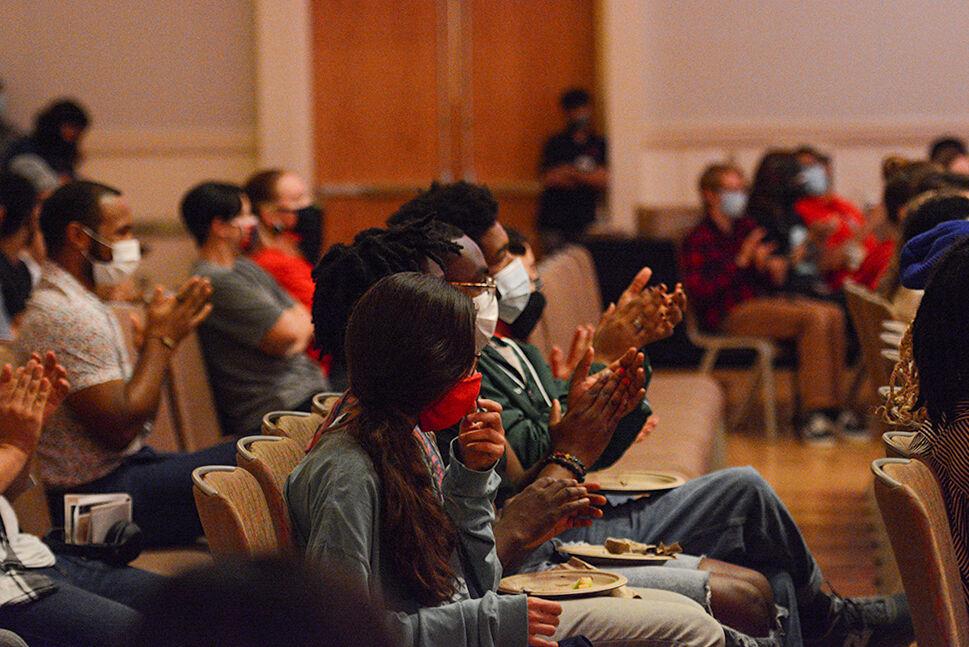
Anna Hansen
The audience applauds the Native performers at the Native American Heritage Month Cultural Show in Talley Student Union on Thursday, Nov. 18, 2021.
On Nov. 18, the Coastal Ballroom at Talley Student Union celebrated thousands of years of rich and diverse history. The message was as loud as the booming of traditional drums: Native Americans are here and thriving.
Hosted by the office of Multicultural Student Affairs, the Native American Cultural Show capped off a series of events celebrating Native American Heritage Month throughout November. In addition to drums, the event included dancing and storytelling performances as well as food, refreshments and information tables.
Lee Chavis-Tartaglia, a first-year studying history and Lumbee Native, highlighted the importance of giving Indigenous individuals the opportunity to share their experiences.
“It’s important so that people can see that we’re still here, we’re still on campus,” Chavis-Tartaglia said. “Maybe our voice isn’t that big, we’re trying to be seen … It’s important for people to really just expand what they know and whose land they’re on. We’re not homogenous, we don’t all look one type of way, we are all sorts of skin tones, and dialects and accents.”
Chavis-Tartaglia represented Native Space, a living and learning village that resides in Wood Hall. Native Space provides incoming Native and non-Native students alike with a community and an opportunity to explore Native American culture.
Another important organization supporting Indigenous students on campus is the Native American Student Association. NASA aims to raise awareness of the Native presence as well as share the various aspects of Native culture.
One dangerous yet common tendency is to reduce Native Americans to a monolith. In the media especially, portrayals of Native Americans and Native culture are riddled with stereotypes. These inaccurate depictions completely oversimplify the diversity of what it means to be Native.
Honiah Locklear, a second-year studying integrative physiology and current president of NASA, strives to eliminate misconceptions about Native Americans.
“When people think Native Americans, they think like a storybook and that we all live in Teepees, we’re all kinda dead, and that’s truly not the case. We’re here, we’re present and we’re actually like your normal everyday people,” Locklear said.
Locklear also emphasized the importance of raising awareness of Native history, which is often ignored and misconstrued. She advocated a petition for a land acknowledgement, a formal statement that recognizes and respects Indigenous peoples as the original stewards of the land we now occupy. According to Locklear, it is important that NC State honors the Natives and their land on which the University was built.
Also in attendance was Olivia Richardson, a Haliwa-Saponi Native. Richardson, adorned in a traditional jingle dress, said she is proud of her culture.
“We try to carry on our traditions and our ways as much as possible because we’re such a small percentage of the population,” Richardson said. “It’s really important for us to be able to continue to pass these stories and these ways onto the next generation and encourage them to pass it on.”
Standing beside Richardson in traditional men’s dance regalia was Landon Brewer, a fourth-year studying civil engineering and Lumbee Native. Brewer ultimately wants to inform younger generations about his culture and instill a sense of pride that runs deep in his own blood.
“When I hear the drums going, I hear the bells, I smell the sweet grass of sage, there’s a feeling in my gut I just can’t explain,” Brewer said. “It just feels right.”
To sign the petition for a land acknowledgement, students can reach halockle@ncsu.edu.